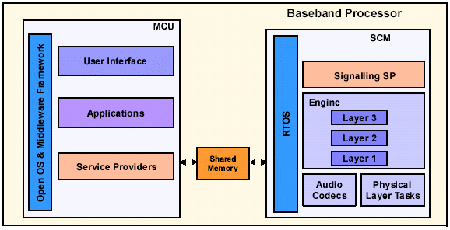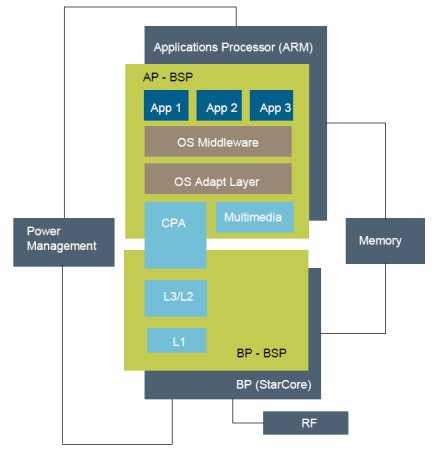Cellphone-on-module supports any Linux phone stack
Feb 12, 2008 — by Eric Brown — from the LinuxDevices Archive — 5 views Freescale is touting the Linux-worthiness of its MXC line of “cellphone-on-module” chips. The Motorola spin-out says the Linux BSP (board support package) supplied with its MXC (“Mobile Extreme Convergence”) chips can support “any of the Linux application frameworks,” ranging from industry… standards to OEM proprietary solutions.
Freescale is touting the Linux-worthiness of its MXC line of “cellphone-on-module” chips. The Motorola spin-out says the Linux BSP (board support package) supplied with its MXC (“Mobile Extreme Convergence”) chips can support “any of the Linux application frameworks,” ranging from industry… standards to OEM proprietary solutions.
Freescale's MXC chips integrate an ARM11 core and a DSP core (digital signal processor) on a postage-stamp-sized die that also contains a chunk of shared memory. Announced in 2003, the MXC architecture debuted in 2005 with the launch of the MXC275-30, based on an ARM1136 core and a Freescale StarCore SC140e DSP (digital signal processor) with VLIW (very long instruction word) instruction processing capabilities. The MXC275-30 went on to see use in Motorola's MotoRokr Z6 (formerly MotoRizr Z6), pictured at left.

MXC software architecture — communications and application software are partitioned on separate processor cores
(Click to enlarge)
 MXC architecture (Click to enlarge) |
Freescale says the MXC architecture naturally segregates application processing from real-time modem control. This segregation is said to shield developers from the complexities of interacting with the modem during the development process. It is also said to let users continually update the application environment, while leaving the baseband environment unchanged and unaffected. Basebands change much less often than application stacks, Freescale points out.
The MXC275-30 module includes the following features:
- Processor — 532MHz ARM1136JF-S applications processor with 208MHz StarCore SC140e DSP
- Modem — EGPRS Class 12/GPRS Class 12; simultaneous voice and data; 850/900/1800/1900 MHz
- Transceiver — direct conversion RF receiver and polar modulated direct digital conversion transmitter, including an analog front end solution and PA module
- Graphics/video — supports CIF 30fps MPEG4/H.264 video
- Other features — security; power reduction; power management with stereo DAC and touch-panel interface; PSAPI (platform services API), single-core modem software
At one time, fellow Motorola spinout Metrowerks supplied Linux BSPs and “CodeWarrior” development tools for Freescale chips. Then, in recent years, more and more silicon vendors began supplying Linux BSPs as a matter of course with their chips, so that customers could evaluate performance more easily. Subsequently, Metrowerks was re-absorbed into Freescale, giving the company its own in-house Linux BSP and tools team.
Stated Tom Deitrich, SVP and GM of Freescale's Cellular Products, “We are enabling the creativity of the Linux community of developers in the world of mobile handset application development.”
Availability
Freescale is demonstrating the Linux version of MXC making live 3G calls this week at the Mobile World Congress in Barcelona (Hall 8, Booth 8B91). The company also announced Windows Mobile support for the chip for the first time.
This article was originally published on LinuxDevices.com and has been donated to the open source community by QuinStreet Inc. Please visit LinuxToday.com for up-to-date news and articles about Linux and open source.